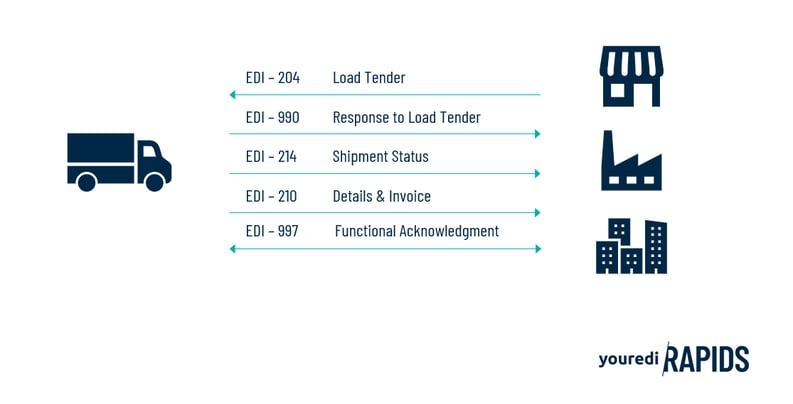This article is the first part of our new Youredi Best Practices Series intended to help all logistics industry actors increase their operational efficiency and grow business.
This part outlines the challenges that parties involved in the truckload tender process encounter when dealing with EDI -204s messages, and presents the solution to overcome those challenges.
Preamble
When an organization books a truckload based on EDI messaging flows, the typical flow of data is as follow:

EDI – 204: Motor Carrier Load Tender
This transaction set can be used to allow shippers or other interested parties to offer a shipment to a full load (truckload) motor carrier. This message is used to transmit information related to detailed schedule of the shipment, Equipment Requirement like size of the required Truck, Ship to Party details like name, location and contact details, material / goods with weight and volume information along with Unit of Measure and shipping instructions.
EDI – 990: Response to a Load Tender
Shippers send EDI-204 Load Tender transaction to Carriers normally for full truckload, and in response to Load Tender transaction, carrier responds with EDI-990 transaction indicating whether the load is accepted or rejected. This transaction can also carry additional information related to acceptance or rejection of the offered load, freight acceptance along with conditions, if any.
EDI – 214: Transportation Carrier Shipment Status Message
EDI – 214 transactions are used by carrier agencies to provide shippers/consignees with the status of their shipment. This transaction can include information related to ship from to ship to location details, address, coordinates, date, and time stamp of pick-up and estimated delivery, shipment information like packing, weight and quantity, and most important information reason for status and exception information. The receipt of shipment status transaction can be optionally informed using EDI – 997 functional acknowledgments (typically not needed).
EDI – 210: Motor Carrier Freight Details and Invoice
EDI - 210 replaces a paper invoice used by commercial truckers and other freight carriers. The 210 transaction is typically sent from the carrier to a shipper, consignee, or third-party payment center for payment of freight charges. One 210 transaction is usually sent for each shipment. It provides an itemized detail of the charges, along with other information you would typically find on a paper invoice.
EDI – 997: Functional Acknowledgment (FA)
This transaction is used to acknowledge the receipt of the EDI transaction by the receiver. This transaction means that the receiver has received the transaction and it is processed by an EDI translator. It may indicate if there are any issues observed in EDI standards for that transaction.
Problem statement: hard to automate the process as every 204 is differently used by your customer
204 messages are based on ANSI X12 standard, like 990, 214 and 210 in this process. However, the standard allows a lot of freedom in how the payload is organized, placed, and used within these messages.
Typically, every company booking the truckloads have their own version of 204, which means that connecting the data flows to your TMS (transportation management system) must be fine-tuned to support the business logic per customer.
The receiving party of the 204s, being a trucking company or brokerage platform, will have to have this logic capability somewhere.
- Most often, the TMS is not the right place, as they lack the flexibility to this extent, they are slow and expensive to fine-tune and keeping in mind that there will not be a status quo; customers are added, some change their processes how to use the data, etc.
- Keeping this in the integration layer makes sense in many cases, but then again, VAN (value-added network) is not the right place either. These are typically old technology platforms running on “steam engines” without too much flexibility, and if it is possible – it will cost a lot of money and take a lot of time.
Solution
Instead of receiving the data from your customers through a VAN or some other connection in customers’ formats, then manually checking the rules and processing the orders and other messages, all this can be configured to happen automatically.
Our industry experts will configure the business logic per customer in the Youredi platform for the 204s (and respectively 990s, 214s, and 210) with your team’s help.
This solution enables you always to receive the data in a harmonized format, specifically supporting your TMS system, process, and data model. This is the most performant and cost-efficient way to automate this process.
Benefits and key takeaways
Your margins grow. You get more bookings. You get more customers with a good rating. You earn more.
You can scale and automate your business’ core backend process.
You will not need personnel to manually touch the data feeds, respond to customer queries and lose your potential margins. The solution is stable and proven and it will alarm of any faulty messages, rejections or anomalies in the defined process, making it possible to react to potential errors before any harm is done.
You can allocate your current EDI team (internal or external) to focus on more revenue-generating tasks, e.g., better customer-facing solutions and services rather than “fixing a leak” in your process.
You can earn immediately by switching away from your “old and safe” provider, who has nicely billed you for many years, increasing unit costs annually and forcing to upgrades regularly.
Your new customers can be easily added with rapid and predictable deployment work and cost, which is not your payroll. You can demand a better service level agreement.
This is a good sales argument for you when you close new business. Your customers don’t like to solve problems on this front either.
In addition, you will get the best practices from the global marketplace delivered to you with a modern technology solution, which is enhancing constantly with additional service offerings to make your business work better.
About Youredi best practices series
Best practices series objective is to share with you - industry stakeholders - information and advice on how to be better and more efficient in this market.
This series focuses on tangible, detailed challenges and respective solutions we have deployed with and for our clients and partners.
These use cases are presented to help companies understand that there is an affordable, modern, proven, and rapid way to solve these challenges.
We have helped many of you to realize added value, and we believe that everyone has the right to enjoy better organized data connectivity technology and services, enabling process automation and scaling.
Youredi works with many local, regional, and global logistics and supply chain management organizations, service providers, software companies, brokers, manufacturers, (e)retailers and others.
If you want to learn more about Youredi or the solutions we provide, don't hesitate to schedule an online meeting with our team of integration experts.


